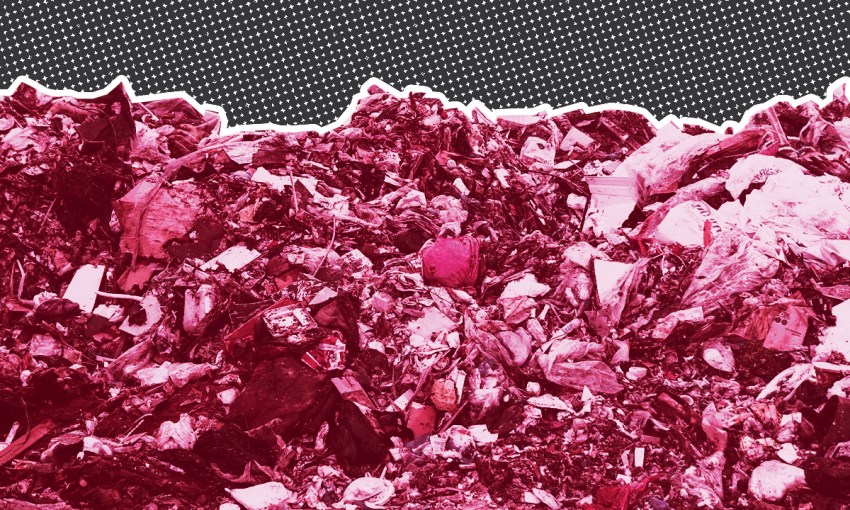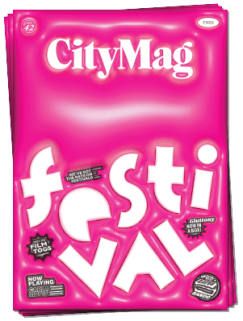We love being the party state – but what happens to the programs, plastic bags and disposable vapes once the busiest calendar month wraps up? We visited the rubbish heap of history, aka the bins of 2023 Mad March.
Dumpster diving: How much waste does Mad March make?
Navigating splashing oil, barking bosses and Hydra-like arms serving festival food is an art form, according to one hospitality food truck veteran we have agreed not to name.
“It’s greasy, hot, loud, stressful, and there’s shouting,” the front-of-house server tells CityMag. “If the service is going well, it’s like you’re part of a well-oiled machine. If the service is not good, it can send the whole operation spiralling.”
For five years the hospo worker has pulled frenzied shifts at some of South Australia’s biggest Mad March events. From behind the till, she trades cash for grub served on varying dishware.
“I’m giving out lots of single-use things, so bits of paper, little cups and bowls,” she says. At the end of the 10-hour shift, she empties the bins, which are almost always overflowing with paper towels, plastic gloves and plastic wrapping. “The waste in hospitality is disgusting,” she says, sighing. “It is a wasteful environment for cleanliness reasons.”
While some Mad March gigs are more waste-conscious than others – some “woke” festivals serve food on plates that can be returned and reused rather than being flicked into the bin, she remarks – others are not.
“At one event at the Adelaide Showgrounds, there was so much food waste,” she says. “I had to throw it all out: all the beef. Boxes and boxes and kilos and kilos of meat. It’s sad.” According to Green Industries SA data, this throw-away culture tracks.
A typical Adelaide event diverts 58 per cent of its waste from landfill when best practice is 98 per cent, according to an event waste report by the government department tasked with resource recovery and innovation. They also found an average Adelaide event recycles 43 per cent of its waste when it should be 86 per cent.
South Australian events should be doing better with their waste, according to their numbers.
Four years ago, this CityMag reporter sought to find out how much trash Mad March makes. We waded elbow-deep into the stink to find out how many cups, plates, programs, nappies, cigarettes and other detritus ended up being reused, recycled or sent to refuse. In short: the 2019 season produced tonnes of garbage.
But last year was the Mad March that smashed “all records” according to the state government, raking in millions of patrons and $906 million in visitor expenditure.
Here’s how much rubbish the greatest season on record made.
THE GARDEN OF UNEARTHLY DELIGHTS
If one festival was awarded the data darling of this story, it would go to the decades-old Garden of Unearthly Delights in Kadlitpina/Rundle Park.
Their publicist told us that patrons of the 24-year-old outdoor festival precinct, comprising 30 food and booze vendors and 14 venues, produced 150 tonnes of waste last year – 30 tonnes less than 2019.
Roughly 40 per cent (60 tonnes) was organic and sent to be mulched or composted; another 40 per cent was commingled rubbish – plastic, metals and paper – destined for recycling; and 20 per cent (30 tonnes) sent to landfill.
Paper and cardboard were “sorted, baled and placed into shipping containers” at the Wingfield Resource Recovery Facility, prepared for an overseas voyage.
Resource company Greenwith Grove copped the 10 cent deposits for the glass bottles, and paper pros Finsbury Green printed 40,000 programs.
South Australian packaging company Salute supplied vendors with tableware stock made of bamboo, sugar cane and cardboard, and it can take anywhere from 180 days to four months for them to biodegrade. (This, by the way, is a drop in the ocean compared to the 500 depressing years it can take for plastic to “decompose”, which is really just breaking into smaller bits of micro-plastic).
ADELAIDE FRINGE
We sent questions to the Adelaide Fringe at the beginning of January about how much garbage the 60-year-old arts festival, the largest in the Southern Hemisphere, made in 2023. Despite a two-and-a-half-week deadline, numerous follow-up emails, Instagram messages and even a LinkedIn nudge, we got crickets from the $4 million government-funded event.
This is what we discovered of the 31-day festival online.
Two years after our first waste investigation, the Fringe launched its Sustainability Action Plan – a seven-pronged policy aiming to “generate positive social and environmental change” in areas like job growth, societal wellbeing and climate change. The document includes a list of lofty goals, and one that caught our eye, slated for a 2025 delivery, is to “devise, implement and review” an Environmental Code of Conduct. The code will include a waste prevention flowchart (even for chemical waste) and other hot rubbish prevention information, expected to be adhered to by all Fringe stakeholders.
From 2021 to 2025, the arts titan is also expected to explore and implement a Carbon Offset policy, “to reduce and offset our total energy usage by 2025,” according to the document. Offsetting carbon emissions by buying carbon credits is a practice currently dividing climate scientists, with some stating the scheme is necessary to battle the climate emergency while others suggest it lacks credibility.
What we know is the 2023 Fringe season featured 1,340 shows, 6,484 total artists, and 4.5 million attendees. We have no idea how much waste it produced.
ADELAIDE FESTIVAL
There were 52 events, 282 performances and 893 artists participating in the 2023 season of the high-brow arts festival, the Adelaide Festival (AF), according to a recent annual report. Although the document does not mention waste, there is a sustainability guide for patrons online, which encourages them to implement green habits, such as “eco-commuting” to the Karrawirra Parri/River Torrens venue.
Waste does exist at the AF though, as a November 2023 tender mentions the state government needing a contractor to “undertake Cleaning & Waste Removal Services” at the Adelaide Festival Centre and Her Majesty’s Theatre.
We have also been a patron there, and have seen the chrome bins with our own beady eyes.
Scotland-born Kath Mainland has worked in and around festivals for 35 years most notably as chief executive of the Edinburgh Festival Fringe Society.
Two years ago the festival veteran moved south-side to take up the top job as AF chief executive.
We asked her about the 2023 waste. Aside from saying South Australian rubbish king Australian Green Clean (AGC) took out the trash, alongside 299 other local events last year, we got no numbers. Kath did say, however, 70,000 AF program guides were printed last year and almost all of the 2023 performances were accompanied by digital-only guides.
Exceptions to the rule were the 1,500 Messa Da Requiem and 500 Chamber Landscapes at UKARIA printed guides.
The AF also looks after the week-long bibliophile blowout, Adelaide Writers’ Week (AWW). Kath reckons AWW punters “would revolt” if the organisers ever scrapped the tangible guides, so to satiate the bookworms 25,000 AWW guides were printed last year.
Catering service Let Them Eat was on food and coffee, and dished it all up on compostable food trays with cups and napkins. (Bottled water is not for sale).
We sent numerous requests to Let Them Eat regarding the quantity of each tableware used but did not get a response.
WOMADELAIDE
Over 100,000 hippies, hipsters and off-kilter music heads shook their harem pants at the 30th iteration of WOMADelaide last year. We sent repeated questions to the festival organisers about what the partygoers left behind, and while we didn’t get the tonnage we were after, a publicist revealed 80 per cent of last year’s waste was composted or mulched; roughly 10 per cent was “non-recyclable, non-compostable waste” sent to resource recovery; almost 7 per cent was sent to Scouts Recycling; and roughly 2.5 per cent of the worst garbage – spanning dirty nappies to other contaminants – went to landfill.
Some 120,000 WOMADelaide programs were printed on plantation timber paper, with 150,000 reusable plastic cups served to patrons. The food vendors, of which there are roughly 50, used biodegradable plates, napkins and other tableware ordered from Salute. We asked WOMADelaide about the quantity of each item ordered, but they said they couldn’t give us the figures. Salute didn’t tell us, either.
In terms of energy, WOMADelaide works with Greening Australia and has offset its carbon emissions through tree planting. As of the end of 2023, WOMAD’s forests cover 107 hectares across Kaurna, Ngarrindjeri and Peramangk Country.
Mains energy plus an unspecified amount of diesel generators power the festival, with fossil fuels expected to be totally gutted from the energy mix at an unspecified date, according to the publicist. Since 2018, WOMADelaide has also been cooking with biogas; it swapped out gas-guzzling generators for B100-powered generators – aka biogas-powered generators.
“In 2024, this rollout is being expanded to all generators of the eligible size, which will see between 50-75 per cent of WOMADelaide’s diesel usage switch from mineral diesel to B100,” the publicist says.
SO…
What’s our verdict? Sure, some festivals manage their garbage better than others, but every festival organiser – and ticket holder – should lift their game.
Contamination is avoided if a punter, food vendor or grip pays attention to which bin is best for their litter.
If everyone is not on their game, the whole lot is spoiled. The same could go for Mad March.





